
Apple pests and diseases
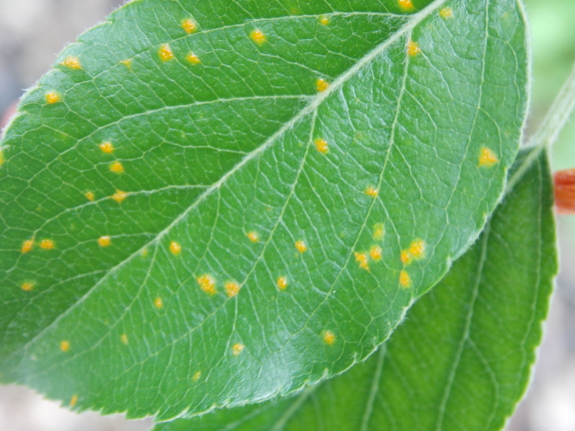
Apples are a magnet for
pests and diseases, and there are various responses to this
reality. Conventional growers just dose the trees with chemicals,
while organic growers tend to use less-noxious-but-still-problematic
sprays. Those
of us who eschew even the organic sprays, though, have to get a bit
more clever, and I start that cleverness off with variety
selection.
Our high-density-apple
planting gave me a
chance to try a lot more varieties than I could otherwise cram into our
core homestead, and I'm taking advantage of that opportunity to see how
each type of apple performs in our climate. The apple disease
that's been our biggest bugaboo in the past is cedar
apple rust, and I
tried to select only varieties that show resistance to the
fungus. Still, I've seen the pretty (but problematic) orange
spots on several of our new trees --- Sweet Sixteen, Grimes Golden,
Pristine (ironic, huh?), Mammoth Black Twig, one of our two Zestars,
and Summer Rambo. All infestations are light to moderate, so I'll
ignore it for now and consider ripping out these varieties if the
fungus seems to be unduly affecting the trees' growth in the future.
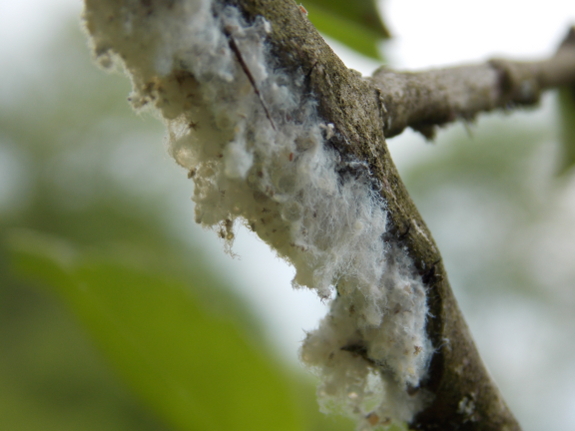
A new problem is woolly
apple aphid, which showed up on the last year's cicada
wounds on some of our older trees. Once I realized the white
fuzz wasn't a fungus, I stopped 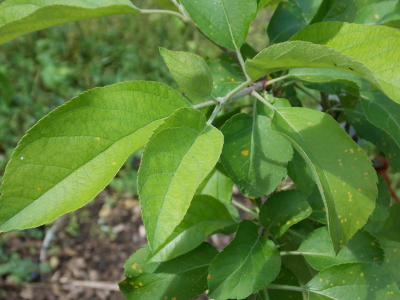 being as concerned, since I'm
quite good at squishing bugs. Woolly apple aphids only become
really problematic when they get into the roots of the trees and cause
leaf yellowing, which may be the case in the Pristine leaves shown to
the left. (All of Pristine's neighbors have darker leaves, or I
would have assumed the yellowing was simply a nitrogen deficiency, but
the issue could also be due to something else I've yet to figure out.)
being as concerned, since I'm
quite good at squishing bugs. Woolly apple aphids only become
really problematic when they get into the roots of the trees and cause
leaf yellowing, which may be the case in the Pristine leaves shown to
the left. (All of Pristine's neighbors have darker leaves, or I
would have assumed the yellowing was simply a nitrogen deficiency, but
the issue could also be due to something else I've yet to figure out.)
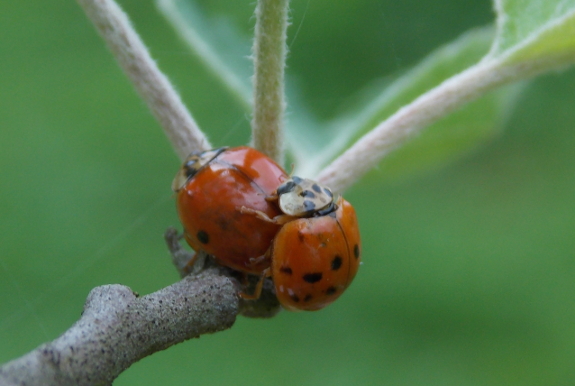
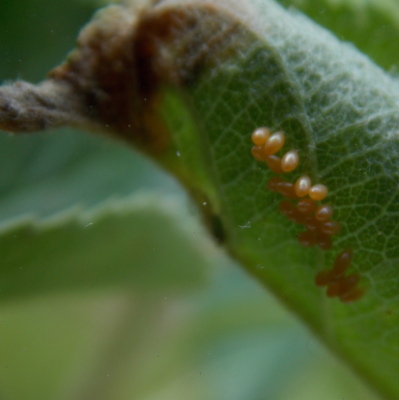
Possible root damage
aside, I suspect the woolly apple aphids will be long gone soon.
I started noticing the white fuzz less than a week ago, and when I went
out to visit the trees Sunday, I saw mating ladybugs and eggs --- the
predator insects are on the job.
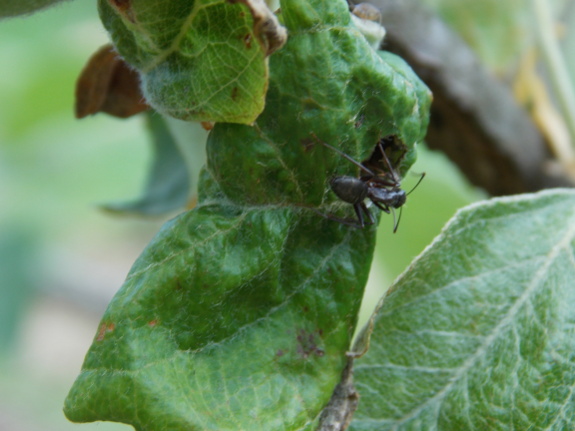
While we're on the topic
of aphids, it's worth noting that the woolly apple aphids weren't on
all the trees with cicada damage, just the Virginia Beauty. On
the other hand, our Yellow Transparent, Winesap, and Enterprise sported
a few curled leaves like the one above, which closer inspection showed
were full of fuzz-less aphids being tended by large black ants.
Once again, I'll let nature take its course here. I've never
known aphids to be more than a passing inconvenience in our diverse
garden.
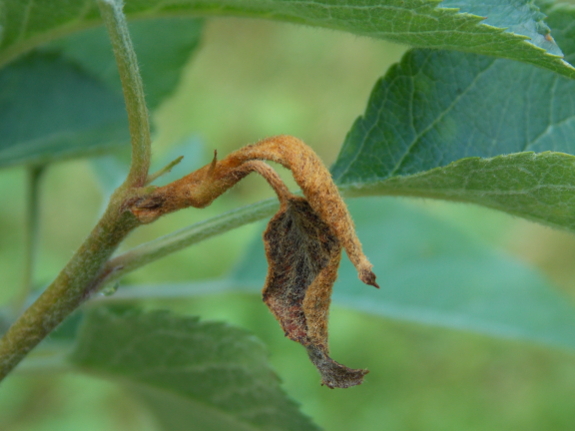
More troubling is the
dead leaf tips like the one shown above, which I'm guessing is the
apple version of fire blight. As with cedar apple rust, I tried
to select only resistant varieties, but apparently Enterprise is more
prone to fire blight than the internet lets on.
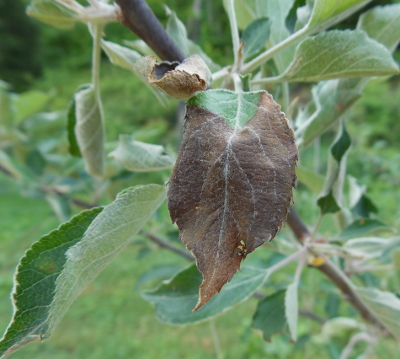 I'm not sure what to think
about the few blackened leaves like the one shown to the left, which I
discovered on our Winesap. Ideas?
I'm not sure what to think
about the few blackened leaves like the one shown to the left, which I
discovered on our Winesap. Ideas?
In case you're keeping
track at home, all of this leaves just a few varieties completely
untouched by insects and disease so far this spring --- Liberty, the
dwarf Yellow Transparent, and Red Empire. So far, the following
varieties have set fruit --- Virginia Beauty, Liberty, Yellow
Transparent (the elder and the the younger), Enterprise, and
Pristine. I'll keep you posted on how the variety selection pans
out later in the year once we've seen how our trees hold up under their
various stresses.
Want more in-depth information? Browse through our books.
Or explore more posts by date or by subject.
About us: Anna Hess and Mark Hamilton spent over a decade living self-sufficiently in the mountains of Virginia before moving north to start over from scratch in the foothills of Ohio. They've experimented with permaculture, no-till gardening, trailersteading, home-based microbusinesses and much more, writing about their adventures in both blogs and books.
Want to be notified when new comments are posted on this page? Click on the RSS button after you add a comment to subscribe to the comment feed, or simply check the box beside "email replies to me" while writing your comment.

Great photos! I have camera envy! I think we are sort of fortunate in a weird way here, in that the area is so high amd dry that nobody gardens, and not much grows. Therefore, the pests havent found us. My tiny little garden last year was pretty much pest free except for a vole issue in one cold frame. No insect damage, might not be so lucky this year. It is good to get a heads up on some of these fruit tree issues. We have two new, small little apple trees that I planted last fall... One cortland and one one thompson county king. ( didnt have ma ny choices by the time I got to the local grower in the fall). They both appear healthy, and are leafing out. The Cortland has blossoms galore ( wich might amount to about 24, since its so small) but the other tree has not one single blossom. Healthy leaf clusters, but nary a flower. Anybody have any ideas why no blossoms on an otherwise healthy tree? And I dont think they froze, because Ive been examining them closely as the buds broke.... Just no blossoms... .??
Deb --- I've noticed a similar thing at my Mom's house. She lives in the city, and there tend to be a lot fewer pests and diseases around. Definitely a benefit!
About your bloom-less tree --- it's probably just too young. Dwarf trees bloom earlier, but apple trees usually have to be five to ten years old before they fruit (depending on the variety). We're only getting fruits on our non-dwarf apples for the first time this year, and the oldest ones went in the ground February 2009. It's a long wait, but hopefully it's worth it.